Physical Therapy


FADavis.com 2022–2023



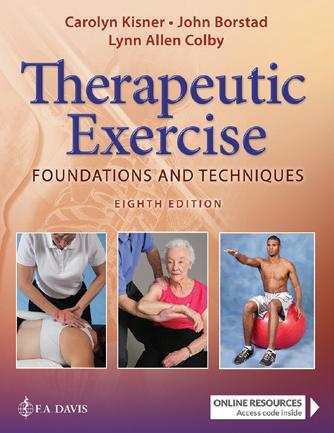

2 Request your eBook! Visit FADavis.com to request your complimentary eBook. 3 WHAT’S INSIDE Access PT 3 Featured 5 Biomechanics & Kinesiology .............................. 8 Documentation 10 Ethics .................................................................. 10 Geriatrics 10 Goniometry ....................................................... 10 Imaging 11 Integumentary & Wound Care ......................... 12 Management 12 Manual Therapy 12 Neurological Rehabilitation 13 Orthopedic 14 Patient Care Skills ............................................. 14 Pediatrics 14 Pharmacology ................................................... 15 Physical Rehab 15 Physical Agents ................................................. 16 Pocket References 17 Prosthetics & Orthotics .................................... 18 Research & Evidence-Based Practice 18 Vestibular Rehabilitation 18 NEW EDITION! Contact your F.A. Davis Educational Consultant today! Email us at Hello@FADavis.com Visit FADavis.com Adopt a title. Ask a question. Learn more. TRY IT FREE FOR 30 DAYS! One digital platform delivers all your students’ TEXTS, REFERENCES, and RESOURCES. The F.A. Davis PT Collection on AccessPhysiotherapy enables physical therapy students to confidently prepare for professional practice; gives educators the tools needed to train the next generation of PTs; and allows practitioners to access the resources and references they need to provide better outcomes for their patients. Anywhere, anytime access Desktop, laptop, or mobile. It’s easy to tap into the information you or your students need whenever and wherever it’s needed. The top resources are always a click away. Find more than 40 titles (and still growing) from F.A. Davis…along with on-demand, how-to videos and interactive case studies as well as teaching tools for instructors and learning resources for students. Preview the F.A. Davis PT Collection FREE FOR 30 DAYS! Email your representative at Hello@FADavis.com FADavis.com/PhysicalTherapy See the next page for a list of titles! NEW EDITION!
O’Sullivan, Schmitz & Fulk
Physical Rehabilitation
Houglum & Bertoti
Brunnstrom’s Clinical Kinesiology Mueller
Communication from the Inside Out Strategies for the Engaged Professional Ciccone
Davis’s Drug Guide for Rehabilitation Professionals
Davenport
Diagnosis for Physical Therapists
A Systems-Based Approach
Gorse, Feld, Blanc & Radelet
Emergency Care in Athletic Training
Fetters & Tilson
Evidence Based Physical Therapy
Hack & Gwyer
Evidence into Practice
Integrating Judgment, Values, and Research
Porcari, Bryant & Comana
Exercise Physiology
Goodman & Helgeson
Exercise Prescription for Medical Conditions Handbook for Physical Therapists
Portney
Foundations of Clinical Research Applications to Evidence-Based Practice
Bonder & Bello-Haas
Functional Performance in Older Adults
McKinnis
Fundamentals of Musculoskeletal Imaging
Bezkor, O’Sullivan & Schmitz
Improving Functional Outcomes in Physical Rehabilitation
Riddle & Stratford
Is This Change Real?
CONTENT LIBRARY
Levangie, Norkin & Lewek
Joint Structure and Function
A Comprehensive Analysis
Fell, Lunnen & Rauk
Lifespan Neurorehabilitation
A Patient-Centered Approach from Examination to Intervention and Outcomes Page
Management in Physical Therapy Practices
Norkin & White
Measurement of Joint Motion
A Guide to Goniometry
Finnegan Medical Terminology in a Flash!
A Multiple Learning Styles Approach
Effgen & Fiss Meeting the Physical Therapy Needs of Children
Johansson & Chinworth
Mobility in Context Principles of Patient Care Skills

Wise & Gulick
Mobilization Notes
A Rehabilitation Specialist’s Guide
Bellew & Michlovitz
Michlovitz’s Modalities for Therapeutic Intervention
McKinnis & Mulligan
Musculoskeletal Imaging Handbook
A Guide for Primary Practitioners
Fenderson & Ling
Neuro Notes
Clinical Pocket Guide
Wise
Orthopaedic Manual Therapy
From Art to Evidence
Beam
Orthopedic Taping, Wrapping, Bracing, and Padding
Dole & Chafetz
Peds Rehab Notes
Evaluation and Intervention Pocket Guide
Carp
Peripheral Nerve Injury
An Anatomical and Physiological Approach for Physical Therapy Intervention
Ciccone
Pharmacology in Rehabilitation
Gabard & Martin
Physical Therapy Ethics
May & Lockard
Prosthetics and Orthotics in Clinical Practice
A Case Study Approach
Hillegass
PT Clinical Notes
A Rehabilitation Pocket Guide
Roy, Wolf & Scalzitti
The Rehabilitation Specialist’s Handbook
Gulick
Screening Notes
Rehabilitation Specialist’s Pocket Guide
Field-Fote
Spinal Cord Injury Rehabilitation
Muth & Zive
Sports Nutrition for Health Professionals
Venes
Taber’s Cyclopedic Medical Dictionary
Kisner, Colby & Borstad
Therapeutic Exercise
Foundations and Techniques
Herdman
Vestibular Rehabilitation
McCulloch & Kloth
Wound Healing
Evidence-Based Management
Kettenbach & Schlomer
Writing Patient/Client Notes
Ensuring Accuracy in Documentation
NEW EDITION!
with significant rounding of the back, the belt may not sit effectively at the waist. For these patients, the belt may need to be placed higher but below the breasts in women. In some cases, placing the belt above the chest and under the arms is the only effective option. In each case, the goal is to create a snug fit so that, if the patient begins to slide downward or fall, the belt is prevented from sliding upward on the patient.
FEATURED
could be compromised by a gait belt. Every situation must be examined individually, but as a general rule, the belt is placed above the vulnerable site. If the belt is placed beneath the site, it will often slide up, causing disruption or injury.
Mobility in Context,
Principles of Patient Care Skills, 3rd Edition
Extra care must be taken with patients who have medical conditions that could interfere with safe gait belt placement. Recent back or abdominal surgical incisions, ostomies (surgically created openings in the body for elimination of body wastes), abdominal feeding tubes, or other lines or tubes in the torso area
Adjustment of the gait belt is usually needed when the patient stands up as the body’s soft tissue at the waist drops.
Charity Johansson, PT, PhD, GCS | Crystal Ramsey, PT, DPT | Sue Chinworth, PT, PhD
Maximize patient care skills.
Correct use of a gait belt can provide valuable pro tection against unnecessary injuries to the patient and the clinician. A gait belt, however, is not a substitute for good body mechanics or patient handling skills during mobility activities. It is also never to be used as a patient restraint.
From positioning and vital signs to transfers and ambulation with assistive devices, this state-of-the-art, multimedia resource teaches students to help their patients progress toward greater mobility and independence. They’ll learn how to navigate confidently in both common and complex clinical situations and to develop the clinical problem-solving and critical-thinking skills they need to succeed.
See the techniques in action
APPLyIng, grIPPIng, And reMovIng A gAIT BeLT
608 pages | 768 illustrations
Spiral binding | Early 2022 $110.95 (US)
ISBN-13: 978-1-7196-4286-6
How to Apply a gait Belt
between the belt and the patient’s clothing when the belt is in place.)
Fifty-five full-color narrated video clips online at FADavis.com show clinicians and patients performing key techniques described in the text.
UPDATED & REVISED! Incorporating current research and practice
The process for applying a gait belt is described next and shown in Figure 11-1.
Instructors
eBook
Image Bank & Test Bank
PowerPoint Presentations
Instructor’s Guide
EXPANDED! More emphasis on diversity, neurological content, and distinguishing between recovery and compensation
1. Let the patient know that you will be using the belt and why; for example, “I’m going to place this safety belt around you so that I have something to hold to in case you need some help.”
NEW! Intervention boxes
Icons highlighting important concepts and care skills
WATCh OUT! A loose belt is a liability. If a patient wearing a loose belt begins to fall, the belt will slide up until it catches, usually under the arms. The sliding belt in itself can injure the patient, and until the sliding belt is stopped, the patient will continue to fall, making a safe recovery increasingly difficult.
Chapter Eleven | Manual Lateral Transfers S EATE d A nd Pivo T 287
could be compromised by a gait belt. Every situation must be examined individually, but as a general rule, the belt is placed above the vulnerable site. If the belt is placed beneath the site, it will often slide up, causing disruption or injury.
Standardized Patient Cases
Students
Video Clips of Techniques
Clinical Decision-Making Case Studies
“Watch Out!” “Keeping Current,” and “Clinical Tips” boxes that cover important safety reminders, recent research, and pointers for effectiveness and efficiency in the clinic
2. Put the belt around the person’s waist with the buckle in the front and slightly to one side for patient comfort during trunk flexion (see Fig. 11-1A). (Gait belts with quick-release buckles should be positioned with the buckle in the back to avoid inadver tent release with trunk flexion.)
“Try This,” “Clinical Reality Check,” “Thinking It Through,” and “Pathophysiology” boxes that enhance learning
5. Lift the far metal loop, causing the teeth of the buckle to grip the belt while you bring the tip of the belt across the front of the buckle and slip it through the metal loop to secure it (see Fig. 11-1C).
Extra care must be taken with patients who have medical conditions that could interfere with safe gait belt placement. Recent back or abdominal surgical incisions, ostomies (surgically created openings in the body for elimination of body wastes), abdominal feeding tubes, or other lines or tubes in the torso area
Adjustment of the gait belt is usually needed when the patient stands up as the body’s soft tissue at the waist drops.
A wealth of clinical examples that mirror today’s patient populations
Over 750 photographs and illustrations to bring concepts to life
6. Readjust the belt as needed to maintain a snug fit.
7. Tuck any excess length of belt into the belt (see Fig 11-1D).
■ The belt should always be placed over the patient’s clothing, never against the patient’s bare skin. If the patient is very thin or frail, you may choose to place a towel between the belt and clothing for added padding.
D E

Correct use of a gait belt can provide valuable pro tection against unnecessary injuries to the patient and the clinician. A gait belt, however, is not a substitute for good body mechanics or patient handling skills during mobility activities. It is also never to be used as a patient restraint.
■ Place the belt so that the metal teeth of the buckle are on the front and the corre sponding metal flap is on the side closer to the patient. (The stitched seam of the belt may face inward or outward, depending on the belt manufacturer.)
APPLyIng, grIPPIng, And reMovIng A gAIT BeLT
How to Apply a gait Belt
3. Pass the metal-tipped end of the belt between the teeth of the buckle (see Fig. 11-1B).
CliNiCAl TiP: It is important to select a correct size belt for your patient. If you do not have a belt large enough for your patient, it is possible to join two belts. Feed the tip of one belt into the metal buckle of the second belt and fasten, leaving at least 4 to 5 inches of overlap. Make sure the buckle is securely fastened before applying the belt.
between the belt and the patient’s clothing when the belt is in place.)
How to grip a gait Belt
The process for applying a gait belt is described next and shown in Figure 11-1.
4. Pull the belt snug but not uncomfortably tight. (You should be able to slide two fingers
1. Let the patient know that you will be using the belt and why; for example, “I’m going to place this safety belt around you so that I have something to hold to in case you need some help.”
Full-color photographs demonstrate proper techniques for both the patient and the therapist.
WATCh OUT! A loose belt is a liability. If a patient wearing a loose belt begins to fall, the belt will slide up until it catches, usually under the arms. The sliding belt in itself can injure the patient, and until the sliding belt is stopped, the patient will continue to fall, making a safe recovery increasingly difficult.
5. Lift the far metal loop, causing the teeth of the buckle to grip the belt while you bring the tip of the belt across the front of the buckle and slip it through the metal loop to secure it (see Fig. 11-1C).
6. Readjust the belt as needed to maintain a snug fit.
2. Put the belt around the person’s waist with the buckle in the front and slightly to one side for patient comfort during trunk flexion (see Fig. 11-1A). (Gait belts with quick-release buckles should be positioned with the buckle in the back to avoid inadver tent release with trunk flexion.)
■ The belt should always be placed over
7. Tuck any excess length of belt into the belt (see Fig 11-1D).
11_Johansson_Ch11.indd 287 23/12/17 12:34 pm
Request preview access • Schedule a walkthrough • Learn more Contact us at Hello@FADavis.com 54
FADavisPTCollection.com Preview the F.A. Davis PT Collection FREE FOR 30 DAYS! Email your representative at Hello@FADavis.com
Chapter Eleven Manual Lateral Transfers S EATE d A nd Pivo T 289
FIGURE 11•1 cont’d (D) Tuck any belt excess into the belt. Grasp the belt behind the patient with an underhand grip. (E) Have the patient lean forward slightly before removing the belt to avoid injury to the patient. Chapter Eleven Manual Lateral Transfers S EATE d A nd Pivo T 287
The gait belt should always be held with a supinated, or underhand, grip (see Fig. 11-1D). This grip allows the maximum restraining force (supplied primarily by the elbow flexors) if a patient requires support during gait or a transfer. The gait belt will slip more easily out of a pronated grip. Never wrap a loose belt
Clinical Tips offer pointers for increasing effectiveness and efficiency in the clinic, while Watch Out! boxes highlight important safety reminders.
with significant rounding of the back, the belt may not sit effectively at the waist. For these patients, the belt may need to be placed higher but below the breasts in women. In some cases, placing the belt above the chest and under the arms is the only effective option. In each case, the goal is to create a snug fit so that, if the patient begins to slide downward or fall, the belt is prevented from sliding upward on the patient.
Resources on FADavis.com
About 1,168 pages
765 Illustrations
Hard cover | Late 2022
About $105.95 (US)
ISBN 13: 978-1-7196-4047-3
Therapeutic Exercise
Foundations and Techniques, 8th Edition
Carolyn Kisner, PT, MS | John Borstad, PT, PhD | Lynn Allen Colby, PT, MS
The premier text for therapeutic exercise!
Help your students understand and apply the principles of therapeutic exercise and manual therapy, including information on surgical procedures and joint manipulation and advanced exercise for returning to sports.
A complete video library of basic therapeutic exercises and techniques online shows students how to achieve the best results for range of motion, stretching, joint mobilization, resistance, and spinal stabilization.


NEW CHAPTER! Exercise for Special Populations
NEW! Information on chronic pain syndrome
Information from Healthy People 2030 presented in Chapter 2
Current ICF terminology and evidence-based research
Expanded discussions of the stages of tissue healing and the phases of rehabilitation in the text and online
Case studies at the end of selected chapters
Exercises for the geriatric patient and increased focus on wellness
Read. Watch. Respond. NEW!
Instructors
eBook
Instructor’s Guide
PowerPoint Presentations
Test Bank
Image Bank
Learning Objectives
Students
Immersive Cases
Video Library

Immersive Cases
Six multimedia, interactive, clinical scenarios online at FADavis.com let students apply theory to clinical practice for individuals with movement dysfunction.
Students assume the role of the clinician as they assess, evaluate, and devise plans of care for patients to progress beyond initial interventions. They’ll hone their critical-thinking skills by addressing the challenges of specific pathologies, patients’ physical abilities and capacities, and developing key post-intervention strategies. Full-color, narrated videos demonstrate multiple options for exercise progressions and help them hone their criticalthinking skills.
Videos
Watch the following videos to view potential intervention options and progressions and then answer the subsequent questions:
Assessment Videos walk students through potential interventions and exercise progressions to help them choose the best strategy for their patient.
NEW EDITION!
Available now!
Therapeutic Exercise Foundations and Techniques, 7th Edition

$98.95 (US)
ISBN-13: 978-0-8036-5850-9
Knowledge Check Quizzes test students’ comprehension of the best treatments for the relevant anatomy and physiology.

Intervention Videos demonstrate the most common exercise progressions to develop students’ problem-solving skills.
Your Patient introduces students to their patient and their health status. Video simulations aid in their assessment.
6 Request your eBook! Visit FADavis.com to request your complimentary eBook.

About 318 pages 374 illustrations Soft cover, spiral binding Fall 2022
About $44.95 (US)
ISBN 13: 978-1-7196-4045-9
Ther Ex Notes
Clinical Pocket Guide, 3rd Edition
Lynn Allen Colby, PT, MS
Carolyn Kisner, PT, MS
The one-stop source for class, clinical, and practice!
Put the information your students need at their fingertips with this handy pocket guide to the proper exercises for their patients. Each joint tab follows a consistent order—general exercises for the specific region, followed by common pathologies and surgeries, with specific interventions for each. Crystal-clear photographs illustrate a wealth of different techniques, while a streamlined format makes the information extremely easy to understand.
Bulleted tables with a progression of exercises Concise exercise guidelines for selected orthopedic pathologies and operative procedures Exercise interventions for mobility, muscle performance, stability, and balance Over 350 full-color photographs illustrating sequences of exercise for the spine and the extremities
Request preview access • Schedule a walkthrough • Learn more Contact us at Hello@FADavis.com 7
NEW EDITION!
FEATURED FEATURED
Resources on FADavis.com
BIOMECHANICS & KINESIOLOGY
Brunnstrom’s Clinical Kinesiology, 6th Edition

Teach kinesiology from a modern, applied perspective. You’ll find clinical applications and exercises for sport, exercise, and rehabilitation.
744 pages | 586 Illustrations | Hard cover | 2012 $103.95 (US)
ISBN-13: 978-0-8036-2352-1
ADOPTION SERVICES
YOUR PARTNER IN SUCCESS!
Direct access to a specialist to answer any questions
Personalized onboarding to help set up your course
Resource library with support materials to make implementation easy
Collaboration on curriculum strategies to ensure the best outcomes
FREE, ONLINE CONSULTATIONS
are available for instructors using our products. You will have access to a dedicated Digital Implementation Consultant who can suggest the best ways to use our products in your course and share best practices and strategies for success.

Learn how Kinesiology in Action can be customized to meet your needs.
Email Hello@FADavis.com or visit FADavis.com/PhysicalTherapy
Resources on FADavis.com
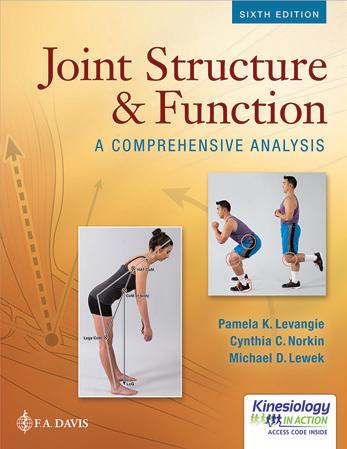
Joint Structure and Function
A Comprehensive Analysis, 6th Edition
Pamela K. Levangie, PT, DPT, DSc, FAPTA
Cynthia C. Norkin, PT, EdD
Michael D. Lewek, PT, PhD
A classic, authoritative text + today’s best technology.
The text and Kinesiology in Action work together to create an interactive learning experience that teaches students the knowledge and skills to effectively evaluate and treat movement disorders.
Focuses on normal structure and function rather than specific patient problems to show how deviations from normal may create or underlie dysfunction.
Prepares students to evaluate and treat human movement disorders with lucid discussions of biomechanics, joint structure, connective tissue behavior, and muscle physiology.
Features an evidence-based approach.
Clarifies key information with more than 800 photographs, radiographs, scans, and illustrations.
Offers case studies and case applications.
Print Text + Kinesiology In Action with eBook
552 pages | 964 Illustrations | Hard cover | 2019
$146.95 (US)
ISBN-13: 978-0-8036-5878-3
Access Card (Online Access Only)
Kinesiology In Action + eBook $126.95 (US)
ISBN-13: 978-0-8036-7599-5
Or Purchase directly at FADavis.com

FADavis.com
ONLINE. INTERACTIVE. ASSIGNABLE.
Kinesiology in Action is the online program that works with your text to make this challenging, must-know content easier for your students to master. It guides them step by step through an immersive, multimedia experience that tracks their progress until they’ve mastered the concepts and are ready to apply them in practice.
Online modules provide the foundation they need to understand both normal and pathologic function, while providing instructors with the information they need to identify students’ strengths and weaknesses.
For Instructors
Customize the learning modules to fit your course syllabus. Track student participation and progress. Use actionable analytics to identify students who are struggling. Intervene and remediate promptly to ensure success.
For Students
Read the integrated e-book. Take a pre- and post-test for each module. Complete the learning/applying activities and exercises.
View the Video Library with over 70 clips. Monitor the Gradebook to assess progress.
Critical-thinking exercises enhance your students’ decision-making skills and are perfect for the flipped classroom.
Video library offers more than 70 video clips that correspond to each learning module.
Learn More. Request Access. Schedule a Walkthrough. Contact us at Hello@FADavis.com
us at Hello@FADavis.com 98 CORE TEXTS
Request preview access • Schedule a walkthrough • Learn more Contact
Peggy A. Houglum, PT, PhD, ATC Dolores B. Bertoti, MS, PT
BIOMECHANICS & KINESIOLOGY
Resources on FADavis.com
INTEGUMENTARY & WOUND CARE
Wound Healing
Evidence-Based Management, 4th Edition
Joseph M. McCulloch, PT, PhD, CWS, FACCWS, FAPTA
Luther C. Kloth, MS, PT, CWS, FACCWS, FAPTA
A volume in the Contemporary Perspectives in Rehabilitation Series
Curated by Steven L. Wolf, PT, PhD, FAPTA, FAHA
The classic text for comprehensive coverage World-renown experts provide evidence-based concepts of wound management that changed the scope of practice today.

768 pages | 380 full-color Illustrations | Hard cover | 2010
$166.95 (US)
ISBN-13: 978-0-8036-1904-3
MANAGEMENT

Management in Physical Therapy Practices, 2nd Edition
Catherine G. Page, PT, MPH, PhD
PT management in all physical therapy practices!
MANUAL THERAPY
Orthopaedic Manual
Physical Therapy
From Art to Evidence
Christopher H. Wise, PT, DPT, OCS, FAAOMPT, MTC, ATC
Resources on FADavis.com

Improving Functional Outcomes in Physical Rehabilitation, 3rd Edition
Edward William Bezkor, PT, DPT, OCS, MTC, CAFS
Lifespan Neurorehabilitation Patient-Centered Approach from Examination to Interventions and Outcomes
Dennis W. Fell, PT, MD
Karen Y. Lunnen, PT, EdD
Resources on FADavis.com
Help your students effectively manage their responsibilities as therapists and take their first steps as managers.
320 pages | 63 Illustrations | Soft cover | 2015
$77.95 (US)
ISBN-13: 978-0-8036-4033-7

Resources on FADavis.com
Supports ALL orthopaedic coursework.
Here’s the most comprehensive look at the different schools of manual therapy that you’ll find! This text discusses each of them, and then walks your students, joint by joint, through examination and interventions. They’ll see how to perform an orthopedic assessment and know how to choose the correct mobilization for their clients.
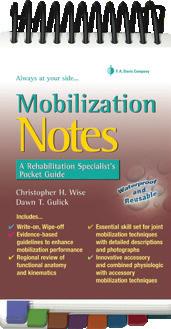
936 pages | 400 Illustrations | Hard cover | 2015
$156.95 (US)
ISBN-13: 978-0-8036-1497-0
Mobilization Notes
A Rehabilitation Specialist’s Pocket Guide
Christopher H. Wise, PT, DPT, OCS, FAAOMPT, MTC, ATC
Dawn Gulick, PT, PhD, ATC, CSCS
242 pages | 250 illustrations | Soft cover | 2010
$38.95 (US)
ISBN-13: 978-0-8036-2096-4
Request your eBook! Visit FADavis.com to request your complimentary eBook.
Susan B. O’Sullivan, PT, EdD Thomas
Reva P. Rauk, PT, PhD, MMSC, NCS
J. Schmitz, PT, PhD
The path to the best functional outcomes
Here is a practical, step-by-step guide to understanding the treatment process and selecting the most appropriate interventions for patients. Superbly illustrated, in-depth coverage shows students how to identify functional deficits, determine what treatments are appropriate, and then implement them to achieve the best functional outcome for their patients.
Learning through reading, seeing, and doing
Seventeen case studies in the text correspond to seventeen video case studies with voice-over narration online. They demonstrate how therapists interact with clients... from the initial examination through the interventions to the functional outcomes.
UPDATED & REVISED! Incorporating current research and practice
NEW! Two additional Case Studies with videos, Patient with Multiple Sclerosis and Patient Status Post Orthotopic Heart Transplant Followed Through the Continuum of Care
Strategies and interventions to promote enhanced motor function and independence in key functional skills
Laboratory practice activities that focus on task analysis and acquisition of psychomotor skills
17 Case Studies in the text with online videos and case study guiding questions, examples of patient management strategies based on effective clinical decision-making for patients with a variety of diagnoses
512 pages | 552 illustrations | Soft cover | 2022 $78.95 (US)
ISBN-13: 978-1-7196-4090-9

Resources on FADavis.com
The text that mirrors the real world of practice
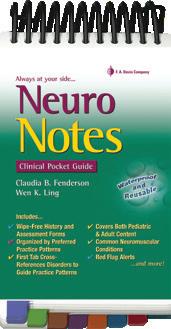
Teach your students to approach neurorehabilitation they way they will practice…based on the constructs of body structure/function and functional activity rather than specific medical diagnoses. This evidence-based approach for patients across the lifespan reflects the APTA’s patient management model and the WHO’s International Classification of Function (ICF).
They’ll begin with examination techniques and interventions for body structure/function impairments and functional activity limitations and progress to the design and application of therapeutic interventions for specific impairments.
1,248 pages | 800 Illustrations | Soft cover | 2018 $146.95 (US) ISBN 13: 978-0-8036-4609-4
Neuro Notes
Clinical Pocket Guide
Claudia Fenderson, PT, EdD, PCS | Wen K. Ling, PT, PhD
336 pages | 106 illustrations | Spiral-binding | 2009
$41.95 (US)
ISBN-13: 978-0-8036-1747-6
12
13
REHABILITATION
NEUROLOGICAL
NEW EDITION!
Examination of Orthopedic and Athletic Injuries, 5th Edition

COMING SOON
Resources on FADavis.com
Chad Starkey, PhD, AT, FNATA Sara D. Brown, MS, LAT, ATC
About 1,024 pages | 1,524 Illustrations Hard cover | Early 2023
About $136.95 (US)
ISBN-13: 978-0-8036-9015-8
Available now!
Examination of Orthopedic and Athletic Injuries, 4th Edition
$136.95 (US)
ISBN-13: 978-0-8036-3918-8

Ortho Notes
Clinical Examination Pocket Guide, 4th Edition
Dawn T. Gulick, PT, PhD, ATC, CSCS
294 pages | 294 Illustrations
Soft cover | spiral-binding | 2018 $41.95 (US)
ISBN 13: 978-0-8036-6657-3
PATIENT CARE SKILLS
NEW EDITION!
Mobility in Context

Principles of Patient Care Skills, 3rd Edition
Charity Johansson, PT, PhD, GCS
Crystal Ramsey, PT, DPT
Susan A. Chinworth, PT, PhD
See page 5 for details
Meeting the Physical Therapy Needs of Children, 3rd Edition

Susan K. Effgen PT, PhD, FAPTA Alyssa LaForme Fiss PT, PhD, Board-Certified Pediatric Specialist
UPDATE
NEW! Update to the 5th Edition Pharmacology in Rehabilitation, Updated 5th Edition

A volume in the Contemporary Perspectives in Rehabilitation Series
Curated by Steven L. Wolf, PhD, PT, FAPTA Charles D. Ciccone, PT, PhD, FAPTA With contributions by Melissa L. Bednarek, PT, DPT, PhD | Kenneth L. Miller, PT, DPT
Resources on FADavis.com
Ensure children with disabilities and special healthcare needs achieve their full potential.
Noted authorities Susan Effgen, Allyssa LaForme Fiss and a team of scholars and clinical experts explore the role of the physical therapist in meeting the needs of children and their families in a culturally appropriate context using a familycentered, abilities-based model.
From the major body systems to assistive technology and intervention support, students will develop the clinical knowledge they need to provide the very best care from initial examination to graduation.
744 pages | 520 illustrations | Hard cover | 2021
$110.95 (US) ISBN-13: 978-0-8036-9727-0
Instructors eBook
Narrated video clips with closed captioning for each in-text Case Study
Image Bank Test Bank
Classroom Learning Activities
Students
Narrated video clips with closed captioning for each in-text Case Study
Resources on FADavis.com
Up-to-date, must-know coverage
Ensure your students understand the rapidly evolving world of pharmacological agents and their impact on rehabilitation. An easyto-understand writing style and easy-to-follow design help them to understand the what, why, and how of this complex subject to ensure the most effective plans of care for their patients.
UPDATED & REVISED! Must-know information on new drugs, revised treatment paradigms for specific diseases, how and why specific medications are being used in new ways, new evidence, and references as well as special considerations for rehabilitation specialists
Clinically focused case studies
Coverage of chemotherapy and cancer treatment and vitamins and supplements
Review questions in each chapter
720 pages | Hard cover | 2022 $94.95 (US)
ISBN-13: 978-1-7196-4534-8
Resources on FADavis.com
Resources on FADavis.com
1,504 pages | 960 Illustrations
Hard cover | 2019
$146.95 (US)

ISBN-13: 978-0-8036-6162-2
Davis’s Drug Guide for Rehabilitation Professionals
Charles D. Ciccone, PT, PhD, FAPTA 1,216 pages | Soft cover | 2013 $81.95 (US) ISBN-13: 978-0-8036-2589-1
PHYSICAL REHABILITATION

Physical Rehabilitation, 7th Edition
Susan B. O’Sullivan, PT, EdD | Thomas J. Schmitz, PT, PhD | George Fulk, PT,
All of the critical information needed to manage patients in a rehab setting!
Here’s a comprehensive approach to the management of adult patients—from integrating basic surgical, medical, and therapeutic interventions to how to select the most appropriate evaluation procedures, develop rehabilitation goals, and implement a treatment plan.
More than 60 narrated, full-color video clips of patients in treatment, including the initial examination, interventions, and outcomes for a variety of the conditions commonly seen in rehabilitation settings
Coverage of current research in basic and clinical sciences with physical therapy assessments and treatment procedures as well as “Evidence Summary” tables
Open-ended clinical case studies to promote critical thinking
14
PEDIATRICSORTHOPEDIC
15 PHARMACOLOGY
PhD
Resources on FADavis.com
Prosthetics & Orthotics in Clinical Practice

A Case Study Approach
Bella J. May, EdD, PT, CEEAA, FAPTA
Margery A. Lockard, PT, PhD
Take a research-based, problem-solving approach.
A clinical focus with unfolding case studies, critical-thinking questions, and over 550 photographs and Illustrations make prosthetics and orthotics concepts easy to understand and apply.
448 pages | 599 Illustrations | Hard cover | 2011
$119.95 (US)
ISBN-13: 978-0-8036-2257-9
RESEARCH & EVIDENCE-BASED PRACTICE
Foundations of Clinical Research

Applications to EvidenceBased Practice, 4th Edition
Leslie G. Portney, DPT, PhD, FAPTA
Evidence Based Physical Therapy, 2nd Edition

Linda Fetters, PT, PhD, FAPTA
Julie Tilson, PT, DPT, MS, NCS
240 pages | 155 Illustrations | Soft cover | 2019
$73.95 (US)
ISBN-13: 978-0-8036-6115-8
PARTNERING FOR SUCCESS
We have helped thousands of educators build more engaging and active courses to drive student success in class, on exams, and in their careers. Whether you are looking to start a new program, new to education, or an experienced instructor—you can count on us to help meet your challenges.
Train successful evidence-based practitioners and researchers. Here is all the information your students need to progress from the analysis of research as the foundation for effective clinical decision making to designing studies and writing their own research proposals.
Resources on FADavis.com
Resources on FADavis.com
VESTIBULAR REHABILITATION
UPDATED, REVISED & EXPANDED! Encompassing changes in the field of clinical research and the growing emphasis on EBP and patient-centered care
NEW CHAPTERS! Translational Research, EvidenceBased Practice, Principles of Clinical Trials, and Qualitative Research
UPDATED! Examples to provide students with a relevant context for understanding designs and analyses
Conceptual descriptions of analytic procedures used in EBP
Guidelines for critical appraisal of various types of studies
Focus on sensitivity/specificity and likelihood ratios, number needed to treat, and measuring clinically meaningful change
696 pages | Hard cover | 2020
$120.95 (US)
ISBN 13: 978-0-8036-6113-4
Resources on FADavis.com
Vestibular Rehabilitation, 4th Edition

Susan J. Herdman, PT, PhD, FAPTA
Richard A. Clendaniel, PT, PhD
Curated by Steven L. Wolf, PT, PhD, FAPTA, FAHA
656 pages | 188 Illustrations | Hard cover | 2014

$183.95 (US)
ISBN-13: 978-0-8036-3970-6
Plan Adopt Discover Connect
Discuss your program needs with our expert team to find the customized solutions that will achieve your curriculum goals.
Receive 1:1 training that makes course set-up easy, saves you time, and improves student retention.
Access powerful tools to stay on top of new standards and test plans, evidence-based educational trends, and effective teaching strategies.
As a family-owned company, your program is important to us and we are committed to providing exceptional customer service.
F.A. Davis is dedicated to your success and eager to discuss how we can make a difference in your program.
Visit FADavis.com or email Hello@FADavis.com to start a conversation.
18 Request your eBook! Visit FADavis.com to request your complimentary eBook.
PROSTHETICS & ORTHOTICS
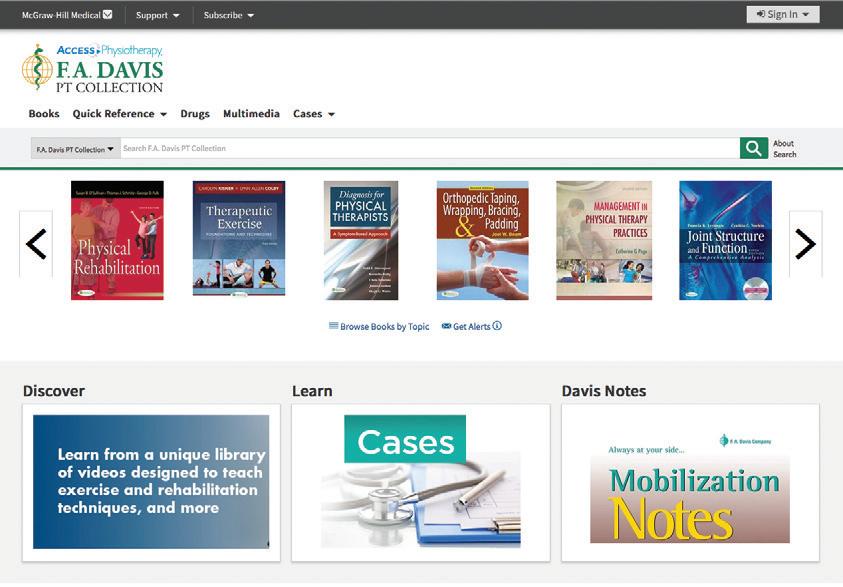

the U.S.A. Content is subject to change and intended for promotional use only. Content and product availability may be subject to
on location. Pricing and special offers
U.S. dollars and
individual orders
only
Contact your F.A. Davis Educational Consultant today! Email us at Hello@FADavis.com Visit FADavis.com Adopt a title. Ask a question. Learn more. TRY IT FREE FOR 30 DAYS! One digital platform delivers all your students’ TEXTS, REFERENCES, and RESOURCES. Preview the F.A. Davis PT Collection FREE FOR 30 DAYS! FADavis.com/PhysicalTherapy Email your representative at Hello@FADavis.com Anywhere, anytime access Desktop, laptop, or mobile. It’s easy to tap into the information you or your students need whenever and wherever it’s needed. The top resources are always a click away. Find more than 40 titles (and still growing) from F.A. Davis…along with on-demand, how-to videos and interactive case studies as well as teaching tools for instructors and learning resources for students.
©F.A. Davis. Printed in
change based
are in
for
in the U.S.
and subject to change. 2022-2023 PT BrochureFADavis.com








































